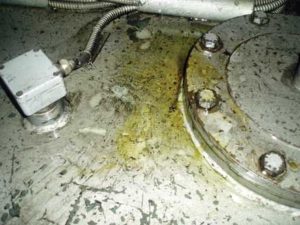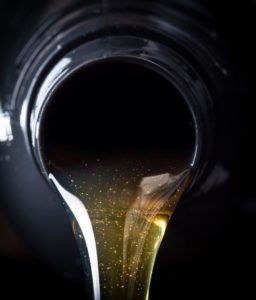Hydraulic oil leakage can result in unreliable performance, increased energy consumption and increased maintenance costs.
Leaks aren’t always easy to spot and often not detected until the damage is already done.
Most leaks are a direct result of wear along the surfaces of hydraulic equipment. However, they can also occur through poor design, inappropriate equipment choice and poor quality control during the manufacturing process. The first obvious signs of leakage are decreased performance, unreliability and increased working temperatures.
Low hydraulic oil viscosity and high temperatures may increase the chance of leaking. Many original equipment manufacturers therefore recommend a maximum viscosity in order for their equipment to operate fully. Meanwhile, choosing the correct oil and sustaining a sensible temperature to retain this viscosity is usually achieved by the end user.
A hydraulic oil leakage can be found in one of two ways:
Infrared thermometers
These are useful for taking unobtrusive measurements of equipment temperature. For instance, abnormal temperatures in relief valves are examples of anomalies that could go undetected, due to the hydraulic system’s cooling or distribution of heat throughout the equipment.
Ultrasonic detection
Ultrasonic detection localises the internal leakage, however it does not confirm how much the component is leaking. Instead a flow meter or similar equipment is used to gain a better understanding of the hydraulic oil leak.
In many cases replacing fluid can be a lot less cost-effective than buying brand new oil. In addition, safety and environmental issues need to be considered.
Dyes that are sensitive to black light are good ways of determining the location of external leaks. This dye is designed to be compatible with both the hydraulic fluid being used and the component surfaces themselves without contaminating the oil. The dye creates a bright green, yellow glow when mixed with the oil and exposed to the black light. As a result, this enables you to see where the leak in coming from in the hydraulic system.
Hydraulic oil contamination
Contamination is a common problem amongst hydraulic components and systems, but there are ways of preventing it.
It is vitally important that your hydraulic oil is contamination-free, as it can degrade the fluid and, eventually cause system failure. It poses the risk of internal leakage, as well as decreasing the control of flow and pressure in valves. Moreover, this could ultimately waste horsepower and produce too much heat. Contamination can form from hydraulic oil, environmental exposure, system wear, the manufacturing process and servicing.
Contaminants
Water can cause corrosion within the hydraulic system and in turn, its components. There are many ways water can enter the system. For example: design flaws, poor maintenance or fluid-servicing procedures.
Contamination may also occur with both miscible and immiscible liquids. This can occur when a hydraulic fluid is put into the hydraulic system without first being cleaned. Some oils do not form insoluble solid materials and are therefore compatibl and subsequently can be mixed without causing harm to the system. However, this could still be classed as contamination, as their properties are not retained within the mixture.
Effects of contamination
Hydraulic oil contamination starts in the oil itself and is then carried through the system. Contaminants produce solids in components and over a long period of time and usage, can reduce productivity and damage equipment.
Particle sizes determine how damaging the contaminant can be. Smaller particles form silt and gradually erode the interior surfaces of the equipment and eventually preventing operation. Moreover, particles that are similarly sized to the clearance between two surfaces can cause the equipment to jam and wear. And finally, large particles block ports, which will result in malfunction and preventing a mechanism from operating.
Hydraulic system malfunctions are categorised in three ways:
- Degradation (wear of the equipment);
- Transient (sporadic failures);
- Catastrophic (complete failure of a system or component).
Preventing contamination
For some hydraulic systems contamination can become a recurring issue. However, the following preventative actions can be taken in order to prevent catastrophic failure.
Choosing the right hydraulic filter
A hydraulic filter is an essential component of any hydraulic system. And selecting the right hydraulic filter is absolutely vital to ensure that particle contaminants are removed from the hydraulic fluid. And even better, before components are jammed or damaged through abrasive wear.
Choosing the right oil
It is vital to ensure that the hydraulic oil you use is the right one for your system. It is also important to refrain from mixing oils, even if the system stipulates that other fluids can be used. If other oils have to be used, the system must be thoroughly cleaned, as in some instances, mixing oils can be detrimental to the system. Finally, always consider environmental and hazardous material regulations when choosing the right hydraulic oil.
Proper fluid handling and storage
Oils should be kept in their sealed containers before useage. The lids of these containers should be checked on a regular basis and secured. If the temperature is constantly fluctuating, it can cause the containers to expand and contract the air and liquid inside. Moreover, temperatures changes can result in moisture in the container, which will produce water in the oil.
Maintaining a hydraulic system
Hydraulic systems sometimes need to be repaired due to frequent use. During maintenance a hydraulic oil health check should always be carried out. And preventative measures should be put in place to prevent contamination.
Water Contamination
Contamination from water is one of the most common causes of oil contamination in a hydraulic system.
Water can find its way into the fluid in a number of ways including worn seals, breathers or condensation. In addition, it may also enter the hydraulic oil through leaking heat exchangers or coolers. To prevent this, your equipment must have high quality design and regular maintenance. However it can be costly and time-consuming to prevent all possible sources of water contamination.
In summary, water can have hugely damaging effects on hydraulic components. Corrosion of the surfaces in the system is the most prominent effect and is caused by free water. Moreover, bearings can be directly affected by this corrosion through metal surface wear and may still be affected even if the water is the fluid has dissolved.
Ways to measure water contamination
The absolute content and the relative content are two different ways to measure the extent of water present in the hydraulic oil and system. Absolute content measures how much water is in the oil in parts per million (ppm). On the other hand, relative content allows you to see what the fluid water content is in relation to its saturation at certain temperatures. The latter method warns you of the imminent creation of free water.
Draining
The separation of contaminants usually happens in the hydraulic reservoirs. The air rises to the surface, whilst the water falls to the bottom. Draining should be a regular occurrence. Therefore automatic drain valves are useful.
Filters
Absorbent filters remove free and emulsified water. The filters contain absorbent polymers, which can be found in the filter matrix. This method isn’t recommended if large amounts of water exist in the oil. And they won’t remove dissolved or strongly emulsified water.
Vacuum dehydration purifiers
These are able to dry water in hydraulic oil by exposing it to a partial vacuum. Flash distillation vacuum dehydration and mass transfer vacuum dehydration are the two common ways of achieving this. Flash distillation applies heat to boil as much water as it can and produces a stronger vacuum. This particular method is more effective because it removes more water from the oils than the mass transfer vacuum. The only disadvantage to this technique is that the combination of the high temperature and strong vacuum can cause thermo-oxidative fluid degradation as a result of the loss of volatile additives.






